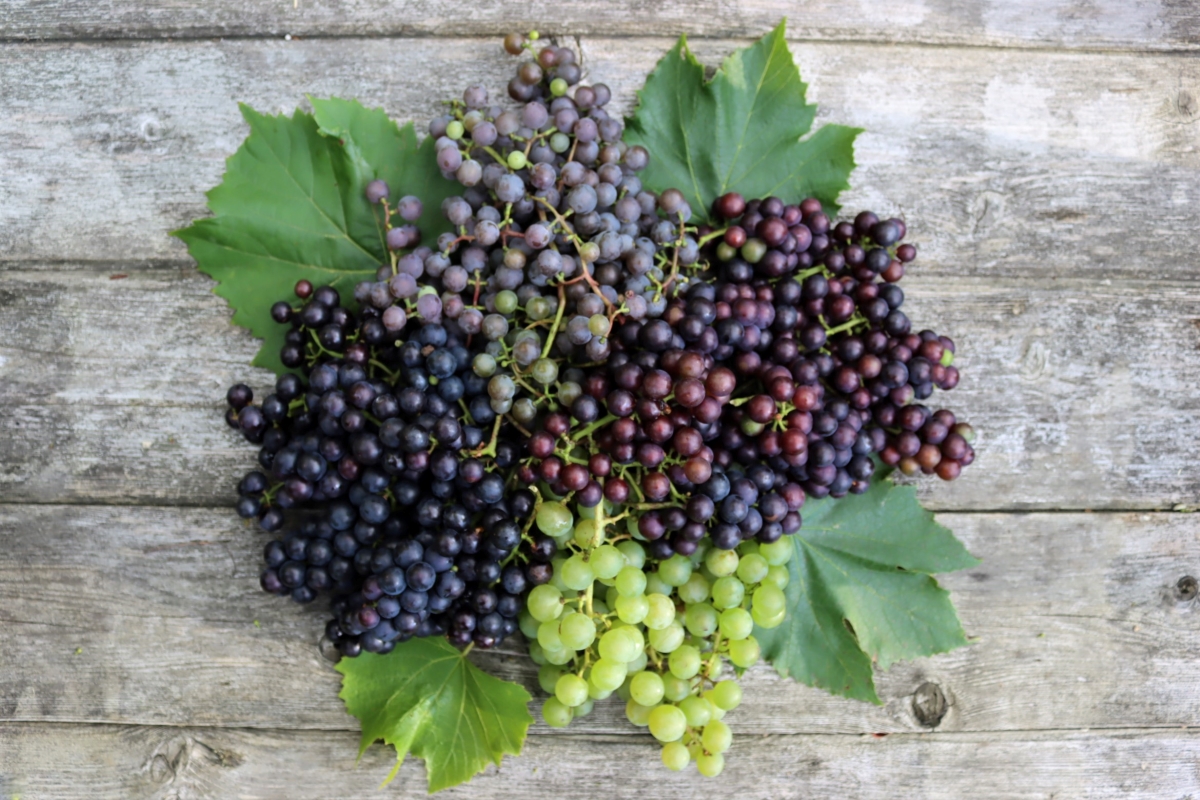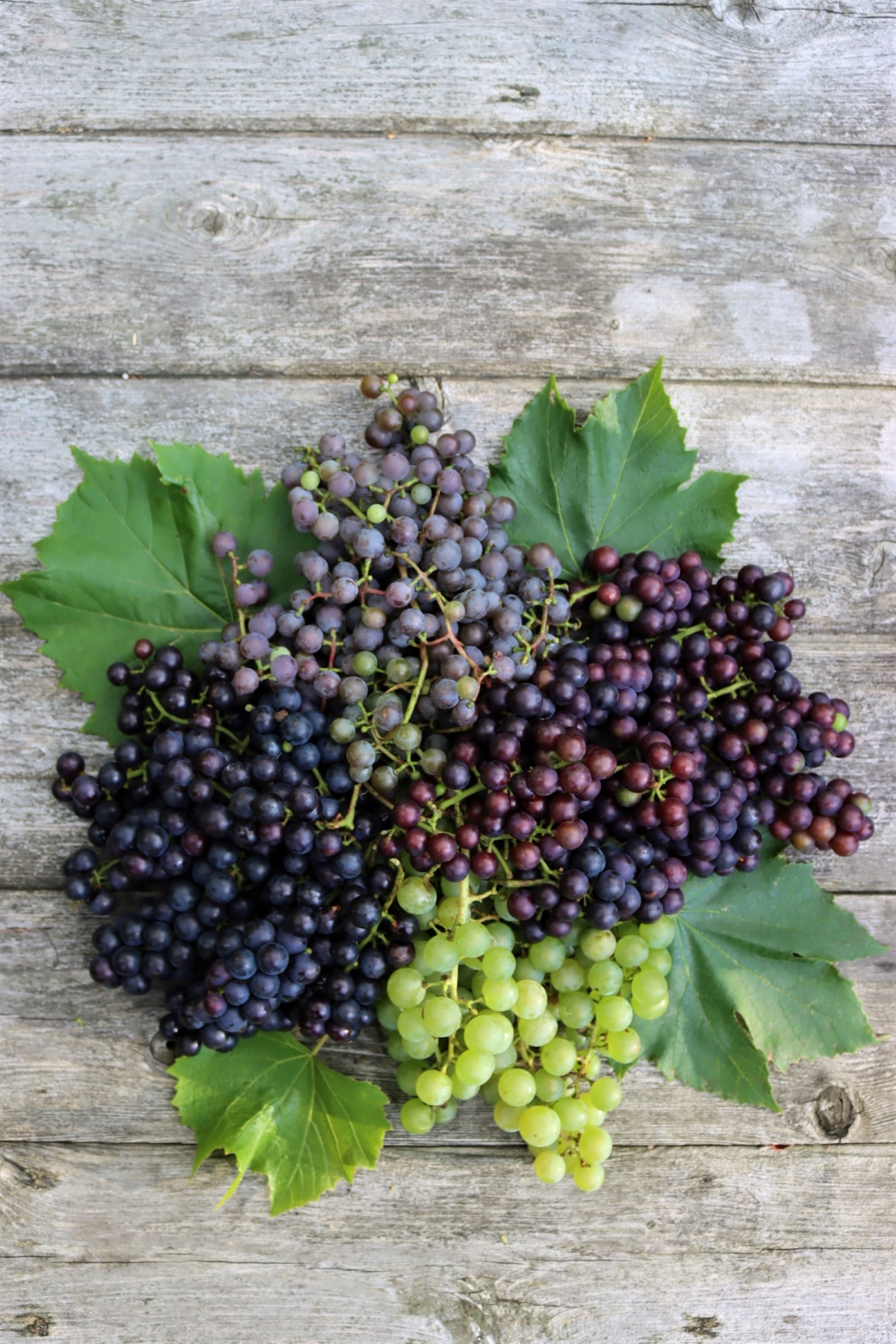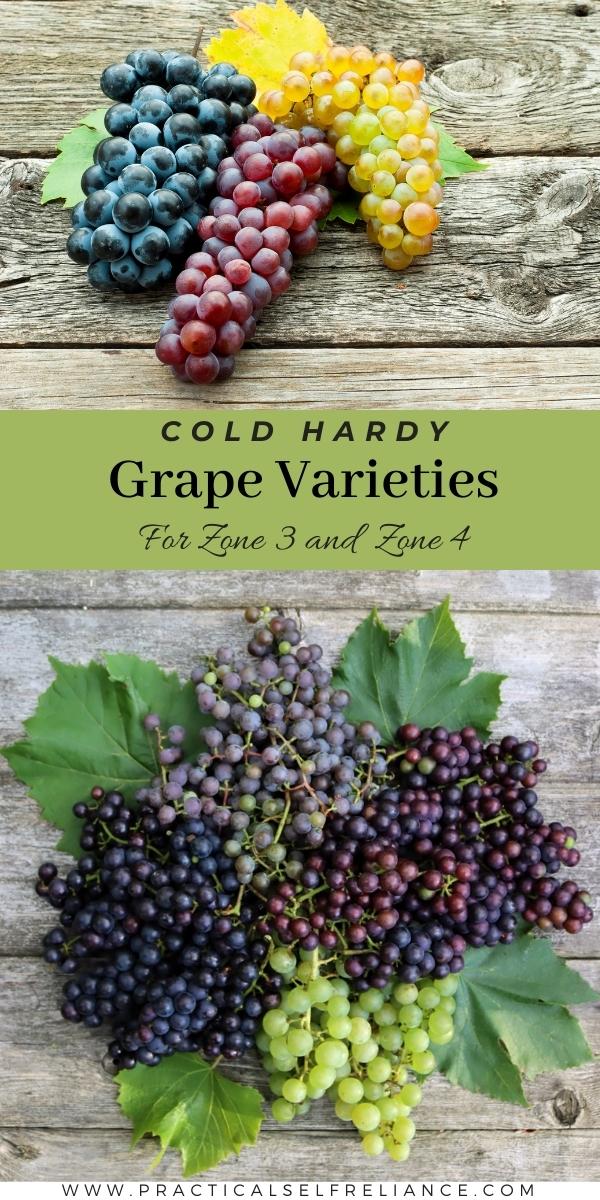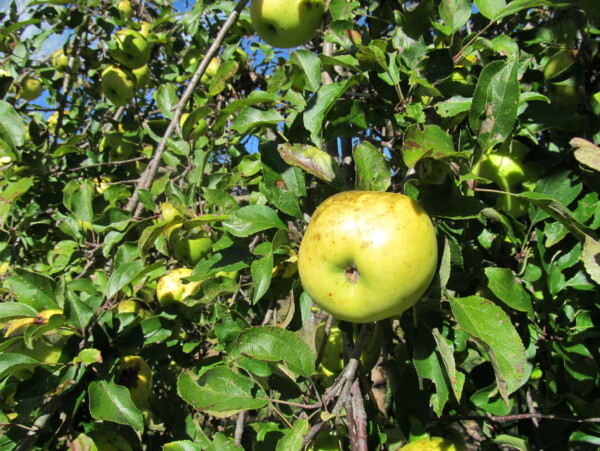Affiliate disclosure: This post may contain affiliate links. Please see our Privacy Policy.
Cold hardy grape varieties can be hard to find, but they do exist, and they’re a great way to add variety to your crops on a northern homestead. Believe it or not, there are nearly 40 different varieties of grapes that you can grow in zone 4!
Most zone 4 grape varieties are wine grapes, which just means they’re intensely sweet (but also often soft-skinned and poor keepers). There are, however, at least ten different zone 4 table grapes to consider as well. They’re absolutely delicious right off the vine and will keep decently if refrigerated.
There are even a few cold hardy seedless grape varieties too!

Table of Contents
- Cold Hardy Grape Varieties
- Wine Grapes Vrs. Table Grapes
- List of Cold Hardy Grape Varieties
- Apenglow
- Atcan Grapes
- Baltica
- Beta Grapes
- Bluebell Grapes
- Brianna Grapes
- Edelweiss Grape
- Frontenac Grape
- Frontenac Gris Grape
- Itasca Grape
- King of the North
- LaCrescent Grape
- Lacrosse Grape
- Landot Noir Grape
- Louise Swenson Grape
- Marechal Foch Grape
- Marquette Grape
- Minnesota 78 Grape
- Morden
- Osceola Muscat Grape
- Petite Amie
- Prarie Star Grapes
- Reliance Seedless Grapes
- Sabrevois Grape
- Somerset Seedless Grape
- St. Croix Grape or ‘St. Croix Red’
- St. Pepin
- Seyval Blanc
- Swenson Red Grape
- Swenson White
- Theresa Seedless Grape
- Toldi Grape
- Trollhaugen Seedless Grape
- Valiant grape
- Vignoles Grape
- Zilga Grapes
- Cold Hardy Fruit Varieties
Grapes were one of the first things we planted here on our Vermont homestead (Zone 4a). We loved fresh grapes, and already made fruit wines, mead (honey wine), and even homemade beer on a regular basis, so they seemed like a logical choice.
Anywhere we had a fenceline, we’d plop down a wheelbarrow full of compost and add in a grapevine. We then promptly forgot about them, and they’ve grown wild without a care ever since.
Our local nursery sold half a dozen varieties, and then when a new nursery opened up that sold 3 or 4 more, we added those too. Looking online, we found Fedco Trees, which sells quite a few cold-hardy grape varieties too.
We’d propagate the grape varieties we really liked, and growing grapes from cuttings is incredibly easy. They’re full-sized productive vines in just 2-3 years.
They’ve always been a part of our homestead, and at this point, we harvest probably 30 to 50 gallons of fresh grapes every single year…and the harvest is the only care they see all year.
When I learned that northern gardeners have trouble sourcing cold hardy grapes that will grow in zone 4, I decided to do this rundown of grape varieties…and I learned there are even more options on there to try.
We grow around a dozen varieties, but there are nearly 40 grapes that are hardy to zone 4 or colder. Some are even hardy down to zone 2!
We’re incredibly lucky to have very well-stocked local nurseries that cater to a fruit-loving permaculture audience, so I never knew they were hard to find! I know that’s not the case everywhere, but most of these grape varieties are available by mail order as well.
Cold Hardy Grape Varieties
This is a list of every cold hardy grape available, and all are known to do well in zone 4. Most are seeded, but there are even a few seedless varieties (only those noted “seedless” in the name).
All told, there are at least 16 grape varieties that can be grown in zone 3, and when you add in the grapes that are hardy in zone 4, you get a total of 38 varieties. Not bad when most people assume there are limited options for grapes in the north.
For zone 3, your options include:
- Atcan
- Baltica
- Beta
- Bluebell
- Edelweiss
- King of the North
- Louise Swenson
- Prairie Star
- Minnesota 78
- Morden
- Sabrevois
- St. Croix
- Swenson White
- Valiant
- Zilga
If you’re in zone 4, you can grow all the zone 3 grapes, plus these varieties as well:
- Apenglow
- Brianna
- Frontenac
- Frontenac Gris
- Itasca
- LaCrescent
- Lacrosse
- Landot Noir
- Marechal Foch
- Marquette
- Osceola Muscat Grape
- Petite Amie
- Reliance Seedless
- Seyval Blanc
- Somerset Seedless
- St. Pepin
- Swenson Red
- Theresa Seedless Grape
- Toldi
- Trollhaugen Seedless
- Valiant
- Vignoles
That’s 22 more varieties for a total of 38 grapes you can grow in zone 4, and new varieties are being developed every year.
In warm zone 4, you may also be able to grow zone 5 grapes with a bit of protection. We are solidly zone 4A, but many people actually grow concord grapes (usually considered zone 5) without issue.

Wine Grapes Vrs. Table Grapes
I’ll go through each type of grape individually to discuss its flavor and characteristics, but sometimes it’s best to work from a shorter list. If you’re only looking for red wine grapes, why should you sort through a full list of every type?
Similarly, many people have no interest in making homemade wine and are just hoping to grow grapes for their table, as well as make juice and jelly.
Here I’ve broken all the hardy grapes down by their most common use.
Cold Hardy Red Wine Grapes
All of these varieties are cold hardy down to at least zone 4, and make excellent red wine. They also may be good for juice and fresh eating, but their main purpose is wine.
- Baltica
- Frontenac
- Landot Noir
- Marechal Foch
- Marquette
- Sabrevois
- St. Croix
- Swenson Red
- Zilga
Cold Hardy White Wine Grapes
For white wine and rose wines, these cold-hardy grape varieties are an excellent choice. All are hardy to at least zone 4.
- Apenglow
- Brianna
- Edelweiss
- Frontenac Gris
- LaCrescent
- Lacrosse
- Louise Swenson
- Osceola Muscat Grape
- Petite Amie
- Prarie Star
- St. Pepin
- Seyval Blanc
- Swenson White
- Vignoles
Cold Hardy Table Grapes
All of these grapes are excellent for fresh eating and are known as “table grapes” or “juice grapes.”
Some are seedless, but most have seeds.
- Bluebell
- Itasca
- King of the North
- Minnesota 78
- Reliance Seedless
- Somerset Seedless
- Theresa Seedless
- Toldi
- Trollhaugen Seedless
- Valiant
List of Cold Hardy Grape Varieties
All of these grape varieties are hardy to at least zone 4, but some are hardy down to zone 3.
Apenglow
A white wine grape that makes a light, neutral white wine. It’s considered low acid and low sugar, so it’s commonly used to blend with very high acid white wine grapes to balance them out without adding much in the way of flavor or otherwise changing their character.
Hardy in zones 4 to 8.
Atcan Grapes
A Russian wine grape that produces green/white grapes with a tan blush. The fruit are small and tart, and generally not used for fresh eating except when extremely ripe. Makes good wine, though the vines are hard to find.
Hardy in zones 3 to 8.
Baltica
A red wine grape with low tannins that makes light fruity wines with a bright red color and cherry aroma. Also goes by the names ‘Hasansky Sladky’ and ‘Varajane Sinine’.
Hardy in zones 4 to 8.
Beta Grapes
Incredibly vigorous vines produce clusters of rich blue/black fruit that’s excellent for juice or jam. Disease resistant and productive. One of the early strains of cold hardy grapes, and ‘Valiant’ (listed below) is considered a similar but superior variety.
Hardy in Zones 3 to 9.
Bluebell Grapes
A cold hardy substitute for Concord grapes developed by the Universtiy of Minnesota. They’re incredibly fragrant with a “concord-like” flavor and large blue/black grapes. Tender skins mean they won’t store long, but they make exceptional juice, jam, jellies, and wines.
One of my personal favorites, and my daughter says they taste “more like grape than grapes,” almost like grape-flavored candy.
Hardy in zones 3 to 9.
Brianna Grapes
A white wine grape that gives wines a pineapple aroma and flavor. It also makes excellent fresh juice.
The fruits ripen in early to mid-September and have a greenish-gold color.
Hardy in zones 4 to 8.
Edelweiss Grape
A large white/green grape with an intensely sweet flavor. Plants are incredibly disease resistant, and it’s one of the most productive grapes on our homestead. It’s known as a table of juice grape generally, but it’s also used to make sweet white wines.
The grapes don’t hold long on the vine, and once ripe, they’ll spoil within a few days to a week. The fruit are soft, and thin-skinned, but the juice yield is exceptional.
Hardy in Zones 3 to 8.
Frontenac Grape
A hybrid grape variety developed by the University of Minnesota’s, it is crossed with a particularly cold-hardy strain of Vitis riparia, or wild riverbank grapes.
Incredibly disease resistant and productive, yielding good crops of small, dark blue/purple grapes in tight clusters. The fruit are very sweet and acidic, but without much “grape” flavor. Generally used for wine rather than fresh eating.
Hardy in zones 4 to 9.
Frontenac Gris Grape
A mutation isolated from Frontenac grapes, the ‘Frontenac Gris’ strain is very similar but produces white grape instead. The fruit are actually a coppery-peach-colored grape, and very aromatic and flavorful (unlike the original Frontenac).
The fruit are said to have the flavor and aroma of peaches or Apricots. It’s considered a muscat-like grape, and it’s used for white winemaking as well as fresh eating.
Hardy in zones 4 to 8.
Itasca Grape
A relatively new cold-hardy grape variety released in 2017, they’re notable for for their low acidity and their sweet flavor. Frontenac gris is one of the parents of this hybrid, and it has a similar white to coppery peach-colored skin.
It’s considered a high quality white wine grape that makes wines with “notes of pear, quince, kiwi, starfruit, gooseberry, and honeydew melon.”
Hardy in zone 3 to 8.
King of the North
A hardy fresh eating or juice grape with deep purple flesh. Hardy in zones 3 to 8.
LaCrescent Grape
A white wine grape developed by the University of Minnesota. It lacks the “foxy” aroma of some other white wine grapes and instead produces wines with aromas citrus, apricot, pineapple, and muscat.
Especially desirable for making “Reisling” type sweet wines. Also lovely as a fresh-eating grape.
Hardy in zones 4 to 8.
Lacrosse Grape
A white wine grape with good disease resistance. It’s usually used to make dry and semi-dry wines with a clean character.
Ripens late in the season, in mid to late September.
Hardy in zones 4 to 8.
Landot Noir Grape
A red wine grape that’s just barely hardy to zone 4 (-20F). Good for warmer locations, but mainly included because it has a very late bud break and is quick to maturity, so it’s ideal for short-season locations.
This red wine grape is known for its ability to withstand long aging in the bottle.
Hardy in zones 4 to 8.
Louise Swenson Grape
A truly excellent white wine grape that produces consistently high quality wines from year to year. It gives the aroma of delicate flowers and honey.
It makes an excellent single varietal wine without blending, as it has good acidity and sugar, though it’s generally noted to lack body. It’s sometimes blended with Prarie Star to address this.
Vigorous grower and dependable producer, though it’s sometimes susceptible to drought and may need irrigation at dry, sandy locations.
Hardy in zones 3 to 8.
Marechal Foch Grape
A hybrid of French and American grapes, Marechal Foch produces light, deeply colored red wines. The vines do well in sandy soil, but have trouble in heavy clay. (For that reason, we don’t grow this one on our heavy clay soils here.)
Hardy in zones 4 to 8.
Marquette Grape
A hybrid grape variety developed by the University of Minnesota’s breeding program. A disease-resistant high, a quality red wine grape that’s also exceptional for fresh eating. The fruit keep remarkably well, and we’ve eaten them into January if refrigerated!
One of the best cold hardy table grapes, in my opinion, even though it’s generally grown for wine.
Hardy in zones 4 to 8.
Minnesota 78 Grape
An older grape variety that’s similar to Beta. The fruit are red-purple and grow on vigorous vines. They’re used for fresh eating, juice, and jelly.
Hardy in zones 3 to 8.
Morden
A variety from Eastern Europe, and considered one of the hardiest grape varieties anywhere. The fruit are excellent for fresh eating, as well as juice or jelly. Sometimes called “Morden Concord” or “Blue Ice Grape.”
Hardy in zone 3 to 8.
Osceola Muscat Grape
A cross between 4 different grape species, this one really combines the good qualities of many different parents.
The juice is sweet and acidic, used both fresh and to make high-quality white wine with aromas of peaches and apricots.
Hardy in zones 4 to 8.
Petite Amie
A white wine grape that’s not commonly grown because it lacks vigor and needs substantial added fertility to produce. It is still grown because it produces lovely muscat wines with a hint of rose petals.
Hardy in zones 4 to 8.
Prarie Star Grapes
An incredibly hardy white wine grape with a neutral character. It’s vigorous and disease resistant.
Usually, this variety is grown to add body to lighter white wine grapes (like Louise Swenson), where the other it’s blended with has more character but little body.
Hardy in zones 3 to 8.
Reliance Seedless Grapes
A pink seedless table grape with spectacular fruity flavor and a melt-in-your-mouth texture. They keep amazingly well, and will store refrigerated for up to 3 months.
Hardy in zones 4 to 8.
Sabrevois Grape
Closely related to St. Croix but hardier. Sabrevois produces small red wine grapes that are highly perishable and best used when still firm.
Hardy in zone 3 to 8.
Somerset Seedless Grape
A pink to red table grape that’s eaten fresh or made into juice/jelly. The fruit starts tart and pink, and is edible at that stage but will be sweeter if allowed to ripen to a full deep red.
One of the few seedless, cold hardy table grapes.
Hardy in zones 4 to 8.
St. Croix Grape or ‘St. Croix Red’
Large Red Grapes in mid-season. Very sweet, and usually used for wine.
Hardy in zones 3 to 8.
St. Pepin
A green grape used to make sweet white wines. This variety is not self-fertile and needs other grapes grown very close by to set fruit.
Hardy to zones 4 to 8.
Seyval Blanc
Supposedly one of the most commonly planted grapes East of the Rocky Mountains, Seyval Blanc is a white wine grape that produces heavy yields of aromatic grapes. The wines they make tend to have sweet green aromas of grass, hay, and melon.
Just barely hardy to zone 4, so plant in a protected location.
Hardy in zones 4/5 to 8.
Swenson Red Grape
A firm red-skinned table grape with a unique sweet strawberry-like flavor. Eaten fresh, or made into white or rose wines. Ripens early, a full month before Concord grapes, so a great option for short seasons.
Hardy in zones 4 to 8.
Swenson White
Large, thick-skinned green grapes are able to keep for extended periods refrigerated (or hand on the vine into late Autumn). They’re late ripening, usually not maturing until early October, so they are not a good choice for short-season locations.
They’re generally used for white wine, and produce wines with moderate acidity and a sweet floral/fruit flavor.
Hardy in zones 3 to 8.
Theresa Seedless Grape
Almost completely seedless, this table grape vine produces excellent purple fruit for fresh eating. Bred by Elmer Swenson’s in Wisconsin. Ripens in early September.
Hardy in zones 4 to 8.
Toldi Grape
Sometimes called “The Concord of the Tundra,” this cold hardy concord-type grape makes exceptional juice and jelly. It ripens a full 6 weeks before Concord, meaning it can be grown in very short-season locations.
Hardy in zones 4 to 8.
Trollhaugen Seedless Grape
A Concord-like table grape with very high sugar content. These ripen extremely early, but then can hang on the plant without deteriorating until the first hard frost.
Hardy in zones 4 to 8.
Valiant grape
A blue grape with firm fruit and a sweet/tangy aromatic juice. Usually used for fresh grape juice and grape wine.
Very productive annual barer of well-filled, tight attractive grape clusters. Bead from ‘Beta’ grapes, and considered an improved variety, with even better hardiness.
Hardy in zones 2/3 to 8.
Vignoles Grape
A high-quality white wine grape that’s known for producing lots of sugar and a good bit of acidity. They’re used to make many different types of white wines, and harvesting at different times will impact the sugar content and character of the wine.
Hardy in zones 4 to 8.
Zilga Grapes
One of the hardiest grape varieties, surviving down to -40F. Small, light blue fruits are produced on incredibly productive vines and are most commonly used to produce red wine. They’re known for being very early ripening, even in areas with cool summers.
Originally from Belarus, but becoming more available in the US recently.
Hardy in zones 2/3 to 8.
Cold Hardy Fruit Varieties
Looking for more fruit to grow in zone 3, zone 4, or zone 5?
- 60+ Unique Fruits and Nuts for Cold Climates (Zones 3 to 5)
- Cold Hardy Peach Varieties for Zone 4
- Cold Hardy Nut Varieties for Zone 4
- How to Grow Hardy Kiwi (Hardy to -40 F)
- How to Grow Sea Buckthorn (Hardy to -40 F)















Hi, I am one year into a permaculture farm in Glover Vt. You mentioned several good nurseries in your area. Can you share their details.
Thank you for all the great info! Maybe one day we can meet in person!
Hi Shelly! So glad to meet you.
The best nursery I’ve found in Vermont is EC browns in Thetford. Kind of a haul for you from glover, but I love that place. Sadly, the nursery is on the market right now, so they may not exist for too much longer if the new owner turns it into a subdivision instead of keeping it going. Check their website and/or call to make sure they’re still open before making the trip.
Second place is East Hill Nursery in Plainfield. Some good options there, but they are mostly pre-order these days and don’t keep much in stock outside of spring. They’re doing their winter bareroot sale right now, and they do get in high quality trees for that (pickup only).
Elmore roots in Elmore has interesting stuff…but they are IMPOSSIBLY expensive. Like 4 to 5 times as expensive as any other option, but interesting varieties sometimes. I’ve just never had the budget for their stuff.
Beyond all these, Fedco Trees has a good mail order nursery that has varieties selected for our climate. All of our grapes came from either EC browns (which has an amazing cold hardy grape section) and a few from Fedco.
Hope this helps!
do you sell grape vine cuttings?
thx, Pat
Not at this time.
Consider adding to your list: Romulus. It is a white/green seedless table grape that is very cold hardy. One of my favorites for growing here in frigid Maine. Delicious!
Thanks for sharing. We’ll check it out.
Awesome list! Thank You! Curious if you would help me by letting me know which of the wine grapes (particularly red but not limited) would do well in a clay soil zone 5a (NY). Trying to explore the option of a vineyard on my new farm. Thanks again!
I don’t have information for your specific region and conditions. You may want to contact a local nursery to see what their suggestions might be.
Southern VT, here. Your website is my favorite, hands down. Every oddball question I google, your website is almost always the first useful hit.. Per your advice, I’m growing cranberry seedlings from last year’s Thanksgiving Ocean Sprays right now!
Wondering when to purchase and plant the grape vines? I’m assuming in the spring, when the ground is just defrosting? I read somewhere that you want to only use first-year vines.
Yes, they should be planted in the spring. Many places sell them for about $12 to $20 each, I’d recommend fedco trees as a source if your climate is anything like ours. They don’t have to be “first year” but you want to trim them back to very short when transplanting older vines, something like 12-18 inches or so.
Wonderful blog! I’ve been growing Concord grapes and making jam for almost 30 years in SW Ohio, zone 5.
I planted a new vine a number of years ago and I don’t what variety it is-can you help me identify it or suggest a useful site for reference? I also thought about asking the Ohio Extension service, but I’m not sure how helpful they might be.
Clusters are small & tight as opposed to the larger, looser Concord clusters. They look similar to the ones on the right side of your photo and the mature leaf looks like the one below them, to the right of the green grapes. I read that the small tight clusters are wine grapes-so we have them fermenting now-our first wine making attempt!
I’m sorry but we don’t have a way to help you identify a specific variety. You could check with your extension service. They’re usually pretty helpful and knowledgeable. Otherwise I would just enjoy the wine.
I am interested in planting seedless grapes in Central New York State. Can all 4 seedless grape varieties
be planted next to each other?
Yes that’s perfectly fine.
You just plant them and leave them alone except for harvest?? I’m trying to wrap my head around what that looks like after a few years, lol. I’m new to grapes. I bought a seedless Concord last year and it didn’t come back. But i pruned it heavy in the fall because I had “messed up” letting several Vines grow on it. I wonder if I stressed it out going into winter, so the idea of just letting it do it’s own thing sounds appealing. Thanks for including that in your article! I love learning that there is more than one “right way” to do things. 🙂 I think I’ll go with a Bluebell to replace it and just see how it goes!
It is a good idea to prune the grapes in the late fall and winter in order to ensure a good crop the following year. In this case, where you have a ton of vines going up, it’s not as important to prune because there is an overabundance of plants which will produce plenty of fruit without the pruning. If you aren’t able to put in this many vines, then you will want to prune them in order to maximize the amount of fruit per vine.
Wow! This is REALLY detailed and far more information than I would have been able to look up quickly – thank you!
Thank you. We’re so glad you enjoyed it.